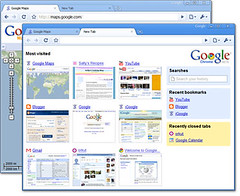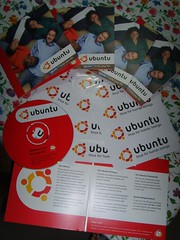
Image via Wikipedia
You may have heard that
GIMP and
F-Spot aren't safe for inclusion in 10.04. 700MB isn't much space to work with Why not question all the applications in
Ubuntu, then? What should be in the default installation? I'll look category by category, but I'll talk a little about why the current defaults are chosen first.
Ubuntu is first and foremost a
GNOME distribution. It takes GNOME applications unless there's a definitive reason not to. For example,
Firefox was originally used instead of the GNOME default
Epiphany browser because Epiphany was in a terrible state at the time, and FF is still preferred because it's a very poplar browser and serves as a familiar signpost to switchers. But mostly, you've got
Totem, Nautlius,
Evolution, and all the gang. Ubuntu thus looks much like any other GNOME distribution.
But it doesn't have to be that way. The questions about The GIMP are great -- they represent a critical look at what should be included. How many people do advanced photo editing? Few, probably. I would guess that the same can be said for PIMminess. Has the average user even even
opened Evolution? Most home users handle all their personal business through web services like
Yahoo! or
Google.
First of all, UBuntu needs to decide whether it wants to be a home or professional operating system. Pro users want different things out of the box. Trying to please both sets of users with one CD is an exercise in frustration. Take a look at the table below to see what groups I think want various features (and keep in mind that it's easy to install these bits if you are an exception).
Application Class
| Current Choice
| Home User
| Professional User
|
|---|
Accessories
| Printing, Calculator, etc.
| Yes
| Yes
|
Games
| GNOME Games
| Yes, and more
| No
|
Photo Manager
| F-Spot
| Yes
| No
|
Bitmap Editor
| The GIMP
| No
| No
|
Vector Editor
| OO.o Draw
| No
| Yes
|
Image Scanner
| XSANE
| On insertion of a scanner
| On insertion of a scanner
|
IM Client
| Empathy
| Yes
| Probably no
|
Personal Information Manager
| Evolution
| Not likely
| Yes
|
Web Browser
| Firefox
| Yes
| Yes
|
Remote Desktop
| VNC Client and RDP Client
| No
| Yes
|
Bittorrent Client
| Transmission
| Yes
| No (a hundred times, "No!")
|
File Synchronization and Back-up
| Ubuntu One
| Yes
| Yes, but not this one
|
Presentation Software
| OO.o Impress
| No
| Yes
|
Spreadsheet Software
| OO.o Calc
| Maybe
| Yes
|
Word Processor
| OO.o Write
| Yes
| Yes
|
Disc Burner
| Brasero
| Yes
| Maybe
|
Video and Audio Player
| Totem
| Yes
| Yes
|
Music Manager
| Rhythmbox
| Yes
| No
|
Using very rough calculations (via
apt-cache show's size), the home user profile above would shave 75-80MB. That's more than enough to add more themes, a video introduction on first run, a video editor, cool games, or other things deemed useful for the home user. The corporate user will only get 60MB or so, but you could then make a case for removing Tomboy so that Mono could be ripped out, saving even more space. What would go in instead? Certainly the would be tools for connecting to directory services. Tracker should be installed and Nautilus should have Tracker functionality re-enabled.
Ubuntu devs are constantly fighting amongst themselves about which applications deserve to be on that tiny, 700MB disk. Serving two different customer bases with one CD just makes that problem worse.


![Reblog this post [with Zemanta]](http://img.zemanta.com/reblog_e.png?x-id=a965fab6-341c-47f4-a87d-9746bddb98f6)

![Reblog this post [with Zemanta]](http://img.zemanta.com/reblog_e.png?x-id=dfcab169-5d95-4a11-aff3-11732f096d20)

![Reblog this post [with Zemanta]](http://img.zemanta.com/reblog_e.png?x-id=8147bad1-7cfa-4a88-8142-6a3dd65b5108)

![Reblog this post [with Zemanta]](http://img.zemanta.com/reblog_e.png?x-id=dd05b1ea-d2b6-4034-afdc-5cd82a2a3026)

![Reblog this post [with Zemanta]](http://img.zemanta.com/reblog_e.png?x-id=c0564185-339b-467a-b2a4-bda38f6a2046)

![Reblog this post [with Zemanta]](http://img.zemanta.com/reblog_e.png?x-id=e9534ae0-684c-44b5-870f-4d20f4d7333e)
![Reblog this post [with Zemanta]](http://img.zemanta.com/reblog_e.png?x-id=1d223845-3c95-4268-9cb6-2c42de1a8c0c)




